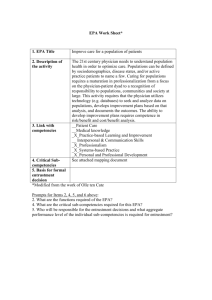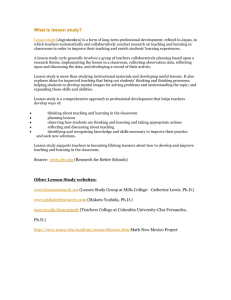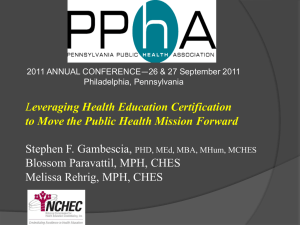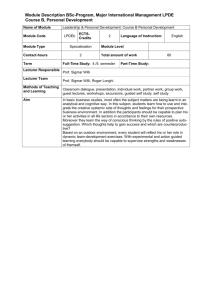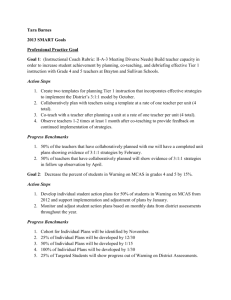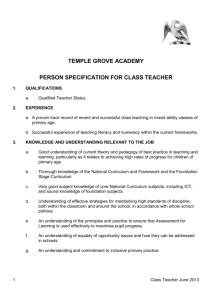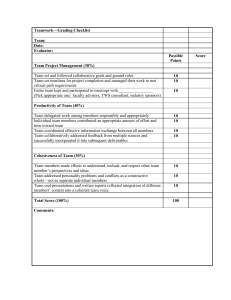English Competencies
advertisement
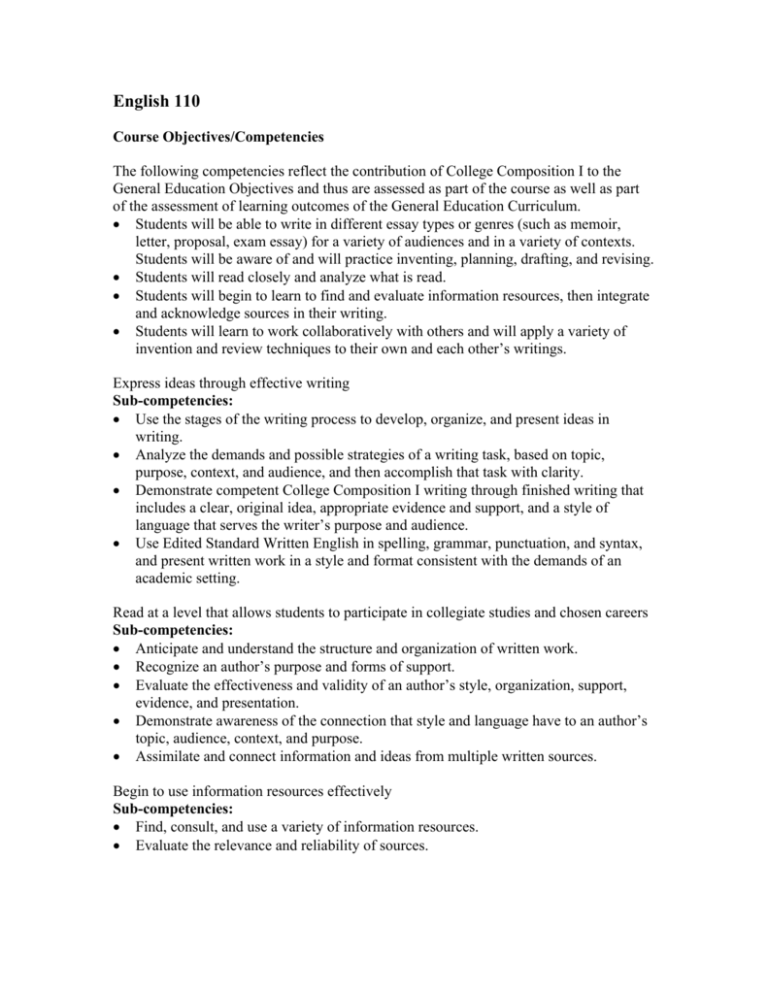
English 110 Course Objectives/Competencies The following competencies reflect the contribution of College Composition I to the General Education Objectives and thus are assessed as part of the course as well as part of the assessment of learning outcomes of the General Education Curriculum. Students will be able to write in different essay types or genres (such as memoir, letter, proposal, exam essay) for a variety of audiences and in a variety of contexts. Students will be aware of and will practice inventing, planning, drafting, and revising. Students will read closely and analyze what is read. Students will begin to learn to find and evaluate information resources, then integrate and acknowledge sources in their writing. Students will learn to work collaboratively with others and will apply a variety of invention and review techniques to their own and each other’s writings. Express ideas through effective writing Sub-competencies: Use the stages of the writing process to develop, organize, and present ideas in writing. Analyze the demands and possible strategies of a writing task, based on topic, purpose, context, and audience, and then accomplish that task with clarity. Demonstrate competent College Composition I writing through finished writing that includes a clear, original idea, appropriate evidence and support, and a style of language that serves the writer’s purpose and audience. Use Edited Standard Written English in spelling, grammar, punctuation, and syntax, and present written work in a style and format consistent with the demands of an academic setting. Read at a level that allows students to participate in collegiate studies and chosen careers Sub-competencies: Anticipate and understand the structure and organization of written work. Recognize an author’s purpose and forms of support. Evaluate the effectiveness and validity of an author’s style, organization, support, evidence, and presentation. Demonstrate awareness of the connection that style and language have to an author’s topic, audience, context, and purpose. Assimilate and connect information and ideas from multiple written sources. Begin to use information resources effectively Sub-competencies: Find, consult, and use a variety of information resources. Evaluate the relevance and reliability of sources. Use information resources ethically and honestly, preserving the meaning of the source and documenting the use of the source in the style appropriate for the student’s discipline or field. Integrate source material smoothly and clearly into the student’s own text. Work collaboratively with others Sub-competencies: Participate in class discussions and in any group projects or activities. Participate effectively in class discussions, peer editing, and group activities or projects, responding productively and respectfully to the work and ideas of others and considering the ideas and suggestions of others with respect and consideration. English 120 Course Objectives/Competencies The following competencies reflect the contribution of College Composition II to the General Education Objectives and thus are assessed as part of the course as well as part of the assessment of learning outcomes of the General Education Curriculum. Students will be able to write academic essays or other genres with clarity and accuracy after learning and practicing the stages of writing. Students will read closely and analyze and appreciate what is read. Students will learn to find and evaluate sources, then integrate and acknowledge sources in their writing. Students will learn to work collaboratively with others and will apply a variety of invention and review techniques to their own and each other’s writings. Express ideas through effective writing Sub-competencies: Use the stages of a writing process to develop, organize, and present ideas in writing. Analyze the demands and possible strategies of a writing task, based on topic, purpose, and audience, and then accomplish that task with clarity, understanding, and sensitivity. Demonstrate competent college-level writing through finished written texts that typically include a clear, original idea, appropriate evidence and support, and a style of language that serves the writer’s purpose and audience. Use Edited Standard Written English in spelling, grammar, punctuation, and syntax, and present written work in a style and format consistent with the demands of an academic setting. Read at a level that allows students to participate in collegiate studies and chosen careers Sub-competencies: Anticipate and understand the structure and organization of written work. Recognize the purpose of a written text, and understand the rhetorical strategies used in a text to convey meaning. Relate the students’ own life experiences to the information in literary, public, scholarly or professional texts. Evaluate the effectiveness and validity of an author’s style, organization, support, evidence, and presentation. Demonstrate awareness of the connection that style and language have to an author’s topic, audience, and purpose. Assimilate and connect information and ideas from multiple written sources. Use information resources effectively Sub-competencies: Find, consult, and use a variety of information resources. Evaluate the relevance and reliability of sources. Use information resources ethically and honestly, preserving the meaning of the source and documenting the use of the source in the style appropriate for the student’s discipline or field. Integrate source material smoothly and clearly into the student’s own text. Work collaboratively with others Sub-competencies: Participate in class discussions and in any group projects or activities. Participate effectively in class discussions, peer editing, and group activities or projects, responding productively and respectfully to the work and ideas of others and considering the ideas and suggestions of others with respect and consideration. English 125 Course Objectives/Competencies The following competencies reflect the contribution of Introduction to Professional Writing to the General Education Objectives and thus are assessed as part of the course as well as part of the assessment of learning outcomes of the General Education Curriculum. Students will be able to present information in a way that effectively communicates a particular message to a particular audience in a style and format consistent with the demands of a professional or technical setting. Students will read closely and analyze what is read. Students will learn to find and evaluate sources, then integrate and acknowledge sources in their writing. Students will learn to work collaboratively with others and will apply a variety of invention and review techniques to their own and each other’s writings. Express ideas through effective writing Sub-competencies: Use the stages of a writing process to develop, organize, and present ideas and information in writing. Analyze the demands and possible strategies of a writing task, based on topic, purpose, and audience, and then accomplish that task clearly and effectively, including the choice of the most effective presentation form for a professional setting. Demonstrate competent technical and professional level writing through writing that includes a clear main point, appropriate evidence and support, and a style of language that serves the writer’s purpose and audience. Use appropriate technology and the principles of format and document design to present information in a design and format that communicates effectively and is consistent with a professional or technical setting. Develop—alone or in collaboration with artists or other professionals—graphics and other visuals to enhance written text. Use Edited Standard Written English in spelling, grammar, punctuation, and syntax. Read at a level that allows students to participate in collegiate studies and their chosen career. Sub-competencies: Anticipate and understand the structure and organization of written work. Recognize an author’s main points and forms of support. Evaluate the effectiveness and validity of an author’s style, organization, support, evidence, tone, and presentation. Demonstrate awareness of the connection that style and language have to an author’s topic, audience, and purpose. Assimilate and connect information and ideas from multiple written sources. Use information resources effectively Sub-competencies: Find, consult, and use a variety of information resources. Evaluate the relevance and reliability of sources. Use information resources ethically and honestly, preserving the meaning of the source and documenting the use of the source in the style appropriate for a chosen discipline or professional field. Integrate source material smoothly and clearly into the student’s own text. Work collaboratively with others Sub-competencies: Participate in class discussions and in group projects or activities. Participate effectively in class discussions, peer editing, and group activities or projects, responding productively and respectfully to the work and ideas of others and considering the ideas and suggestions of others with respect and consideration.
